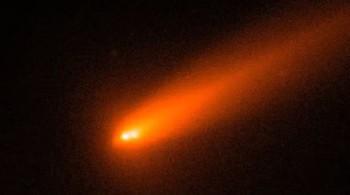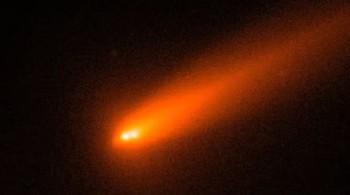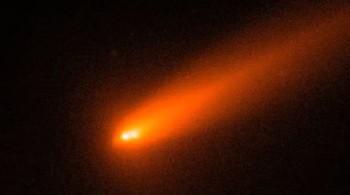
Comet C/2025 K1 (ATLAS) breaks into 3 after coming close to Sun
In a rare and fascinating astronomical event, Comet C/2025 K1 (ATLAS) has broken into three pieces after swinging too close to the Sun. This extraordinary occurrence was captured by astronomers using Italy’s Copernicus telescope, providing a unique glimpse into the comet’s unstable state. The comet’s nucleus became unstable after it passed close to the Sun on October 8, resulting in the break-up of the comet into three distinct pieces.
The two largest chunks of the comet drifted approximately 2,000 kilometers apart from each other, while a smaller third piece was visible to the left of the pair. This remarkable event has sparked intense interest among astronomers and space enthusiasts, offering a rare opportunity to study the dynamics of cometary break-ups.
Comet C/2025 K1 (ATLAS) was first discovered in May 2025 by the Asteroid Terrestrial-impact Last Alert System (ATLAS) survey. Initially, the comet was expected to be a relatively small and unremarkable object, but its close approach to the Sun on October 8 changed everything. As the comet drew near the Sun, the intense heat and radiation caused the comet’s ices to vaporize, leading to a rapid increase in the comet’s activity.
The break-up of Comet C/2025 K1 (ATLAS) is not an unprecedented event, as comets are known to be fragile and prone to fragmentation. However, the proximity of this event to the Sun makes it a unique and fascinating case study. The comet’s close approach to the Sun, known as perihelion, marked the point at which the comet’s gravity was no longer strong enough to hold it together.
The use of Italy’s Copernicus telescope to capture the break-up of Comet C/2025 K1 (ATLAS) highlights the importance of advanced astronomical instrumentation in studying celestial events. The Copernicus telescope, located in Italy, is a state-of-the-art facility that provides high-resolution images of the night sky. The telescope’s advanced optics and sensitive detectors allowed astronomers to capture stunning images of the comet’s break-up, providing valuable insights into the comet’s composition and dynamics.
The study of cometary break-ups like Comet C/2025 K1 (ATLAS) offers valuable insights into the formation and evolution of our solar system. Comets are thought to be remnants from the early days of the solar system, and their composition and structure can provide clues about the conditions under which the solar system formed. By studying the break-up of comets like Comet C/2025 K1 (ATLAS), astronomers can gain a better understanding of the processes that shape the solar system and the potential risks posed by cometary fragments.
In conclusion, the break-up of Comet C/2025 K1 (ATLAS) into three pieces after its close approach to the Sun is a remarkable astronomical event that offers a unique glimpse into the dynamics of cometary break-ups. The use of advanced astronomical instrumentation, such as Italy’s Copernicus telescope, has allowed astronomers to capture stunning images of the comet’s break-up, providing valuable insights into the comet’s composition and dynamics. As astronomers continue to study this event, they may uncover new clues about the formation and evolution of our solar system.
The break-up of Comet C/2025 K1 (ATLAS) also serves as a reminder of the awe-inspiring beauty and complexity of the night sky. As we continue to explore and study the universe, we are constantly reminded of the many mysteries that remain to be uncovered. The study of comets like Comet C/2025 K1 (ATLAS) is an exciting and dynamic field of research, and one that continues to capture the imagination of astronomers and space enthusiasts around the world.
For more information and stunning images of Comet C/2025 K1 (ATLAS), please visit the news source:
https://www.moneycontrol.com/science/comet-c-2025-k1-atlas-splits-into-three-after-sun-encounter-see-stunning-images-here-article-13675154.html/amp




